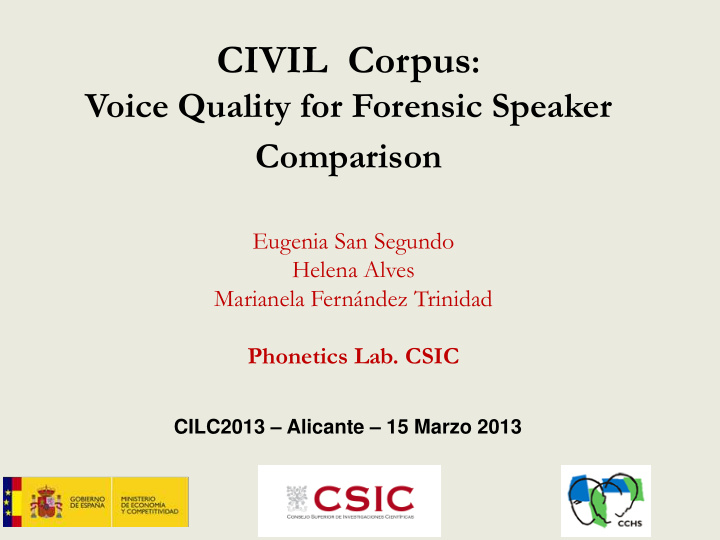



CIVIL Corpus : Voice Quality for Forensic Speaker Comparison Eugenia San Segundo Helena Alves Marianela Fernández Trinidad Phonetics Lab. CSIC CILC2013 – Alicante – 15 Marzo 2013
CIVIL Project C ualidad I ndividual de la V oz en la I dentificación de L ocutores • 2010 • Phonetics Lab CSIC • Laryngeal settings modification FORENSIC PHONETICS
Types of Voice Transformation (non electronic) 1) Phonation disguise: • whisper (Orchard y Yarmey 1995 & Yarmey et al. 2001, Evans & Foulkes 2009) • falsetto (Endres, Bambach & Floss 1971, Wagner & Köster 1999, Künzel 2000, Alves et al. 2012 ) • creak/creaky ( Hirson & Duckworth 1993, Moosmüller 2001 Künzel 2000, Alves et al. 2012) 2) Prosody disguise : pitch, intonation, speech rate (Dellwo, Ramyead & Dancovicova 2009 & Dellwo, Kolly & Leemann 2012)
Types of Voice Transformation (non electronic) 3) Supraglottal disguise: • Through objects (Molina de Figueiredo & Souza Britto 2000; Horga, 2002) • Techniques that interfere within the habitual speech transmission (Rose & Simmons 1996, Llamas et ál. 2008, Gil & San Segundo 2013) 4) Phonological system disguise: foreign accent, dialectal or pathological features (Zhang & Tan 2008, Tate 1979, Markham 1999, Storey 1996, Moosmüller 2006, Simpson & Neuhauser 2009, 2010)
Disguise as a Challenge in Forensic Phonetics Most criminals do not combine all these disguising techniques (Masthoff 1996). The most frequently used is the voluntary modification of the phonation types. This kind of disguise is specially difficult to maintain for a long stretch of time (Künzel 2000).
CIVIL: hypotheses • Changes in phonation = harmful for speaker recognition • Idiosyncratic phonetic features (biometric traces): – Remain despite the disguise attempts – Some laryngeal characteristics cannot be disguised
Types of Phonation • Phonation = vocal folds vibration From: http://www.phys.unsw.edu.au/jw/voice.html
Types of Phonation • Different states of the vocal folds produce different types of phonation Falsetto -adducted +tense elongated Modal adducted tense ------------- Creak/y +adducted -tense shortened
Corpus CIVIL • 31 female speakers and 27 male speakers • Standard European Spanish • 20-35 years old mean 25.6 years old • Two recording sessions mean 29.8 days Why? Forensically realistic Non-contemporaneous speech samples ( - ) Within-speaker variation (+) Between-speaker variation
Corpus CIVIL • Three tasks: • Voice Signal: – 3-4 minutes of conversation – Microphone – 33 carrier sentences – Telephone – 2 texts – EGG • Three Types of Phonation: – Modal – Falsetto – Creak/y
Electroglottograph Measures the time variation of the degree of contact between the vibrating vocal folds Pérez Sanz, C . Ajustes laríngeos y estilos de habla en radio y televisión (Ph.D.)
Recording Equipment & Settings • Equipment – Recording booth of the CCHS Phonetics Lab – Condenser microphone E6i Omnidirecctonal Earset Audio Interface UA-25EX by Roland – PC with the software Adobe Audition 1.0 for Windows – Telephones CISCO IP Phone as emitter & Samsung Galaxy as receiver – Electroglottograph Glottal Enterprises EG2-PCX2 • Settings: – Sample Rate: 44100 – Resolution: 16-bits – Channels for voice: Stereo (L-microphone & R-telephone) – Channels for EGG: Stereo (L-microphone & R-EGG)
Results so far – Alves et al. (2012) Disguised voices: a perceptual experiment , 3rd European Conference of the International Association of Forensic Linguistics, Oporto . • Listeners ’ recognition of disguised voices is above chance (p < 0.001 ***) • Speakers are worse recognized when using creak than when using falsetto. • No performance differences between experts and naïve listeners in disguised voice recognition FEMALE VOICES !!
Future directions… MALE VOICES ? -Hypothesis: Worse recognition results when using falsetto - Expectations not met: - Creak less expected for female voice prototype - Falsetto less expected for male voices prototype
CIVIL Corpus : Voice Quality for Forensic Speaker Comparison Thank you for your attention! eugenia.sansegundo@cchs.csic.es helena.alves@cchs.csic.es marianela.fernandez@cchs.csic.es CILC – Alicante – 15 Marzo 2013
Recommend
More recommend